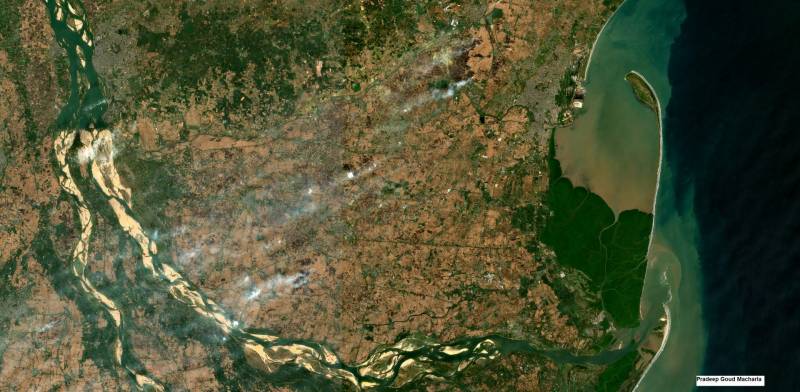Farm fire caught on Satellite: It's happening here at Godavari delta in AP
By Dheeshma
Highlights
- Expert blames stubble burning
- Calls for better use of grass
Hyderabad: Satellite data acquired by Sentinel-2 reveals that Andhra Pradesh and Telangana State are not spared from crop fires. The satellite image shows an aerial view of the crop fires in Godavari delta.
Over 40 lakh acres of agriculture land are being burnt every year across west and east Godavari districts, particularly for the last seven years. This is carrying polluted air to the interior of Andhra Pradesh and some parts of Telangana.
Mahesh Palawat, Chief Meteorologist, Meteorology and Climate Change, told NewsMeter, “Krishna, Guntur, Nalgonda and Kurnool districts of AP and Sangareddy, Kammam, Mahabubabad, Suryapet districts in Telangana receive polluted air due to stubble burning in Godavari delta. It is similar and as worse as the smoke from fields in Punjab and Haryana that are polluting Delhi.”
Cropfires reported near Godavari Delta Region acquired by #Sentinel-2 on Dec-07-2019.
🛰️Data: @CopernicusEU
📽️Processed in @googleearth @AdobeAE pic.twitter.com/jtrQddHTOp
— Pradeep Goud Macharla 🌍 (@Macharlazz) December 8, 2019
Elaborating further, he points out, “Wind is usually the medium to carry smoke from stubble burning. Currently wind is moving from east (Bengal) to west. Hence, smoke will be carried towards western and south-west direction and impact districts like Godavari. Air Quality Index of PM 2.5 will deteriorate in the region.”
The method of burning crop waste is prevalent in AP. Every year, around 30 lakh farmers from the Godavari delta burn residue after harvesting rice.
C. Changal Reddy, Chief Adviser, Consortium of Indian Farmers Association told NewsMeter, “Rice is widely cultivated here. Threshing machines are used to remove rice stalk that remains on the field. This has left crop residue in the form of stubble. Burning it on the field is the cheapest option available for us.”
Burning grass on the farm has not only created pollution but also eliminated edible food for livestock in the neighbouring villages. According to farmers in the region, they have been reporting about this to the authorities for the past years.
Mr. Reddy added, “Grass is as important as grain. Earlier, we had cattle to be fed and there was no requirement for burning the leftover grass. Grass is a good food for livestock and they need it. However, today only a few engage in cattle farming. Hence the only way to overcome the problem of stubble burning is transporting the leftover stubble to neighbouring villages.”
“However, we need the support of authorities to execute this. Selling grass could help a farmer earn Rs 1,000-2,000. Similarly, this will help farmers who have livestock. Grass will increase milk yield and their income,” Mr. Reddy added.